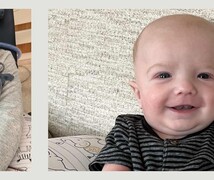When three-month-old Asher Hobby needed a heart transplant, his parents eagerly agreed to help to save another life at the same time. In June 2023 at Duke Health, Asher received a new heart from a deceased donor -- then the healthy valves and arteries from Asher’s old heart were transplanted into another infant with heart disease. Months later, both children are growing stronger and healthier every day.
The innovation, known as a domino heart transplant, builds on the technique of partial heart transplantation pioneered at Duke in 2022 and may increase the number of hearts available for children in need. Instead of using mechanical valves that require multiple revision surgeries over time, the partial heart transplant uses human valves that will grow along with the child.
“It’s probably one of the biggest advances in congenital heart surgery in the last 40 years,” said Duke pediatric heart surgeon Joseph Turek, MD, who led both surgeries. “It's a wonderful setup where two children can benefit from one initial gift.”
Watch to learn more about Asher's progress.
Rare Complication Leads to Heart Disease
Greensboro, NC residents Kayle Cooper and Drew Hobby became concerned when their newborn son Asher stopped eating normally. Local doctors discovered Asher's heart muscle was damaged beyond repair. Cooper and Hobby brought Asher to Duke, where he was hospitalized and placed on the national heart transplant waitlist.
Domino Approach to Transplant
Several months later, Asher's parents got the news they’d been waiting for; Asher had been matched with a donor heart. The opportunity came with a chance to help another child with heart disease, one who needed new heart valves. Although Asher’s heart muscle was damaged, his heart valves were healthy. “When we were asked if we would like for Asher’s heart valves to be donated, we immediately said ‘yes, of course we would!’” Cooper said.
Two Children, Two Surgeries, Two Days
First, Asher’s heart was removed and replaced with the donor heart. Then, instead of discarding Asher’s old heart, surgeons harvested its healthy valves and arteries and transplanted them into the other child at Duke the next day. Four months later, both children are growing and meeting important developmental milestones.
Looking to the Future
Dr. Turek hopes more pediatric heart centers will adopt the domino heart transplant approach to save more babies’ lives. “Twenty percent of infants waiting for a heart transplant won’t get one,” he said. “Finding a way to double the number of patients who can receive the gift of organ donation is going to help so many children who may have otherwise died waiting on a heart transplant. My mission is to spread this idea to other institutions and make it available for kids across the country and hopefully across the world.”





